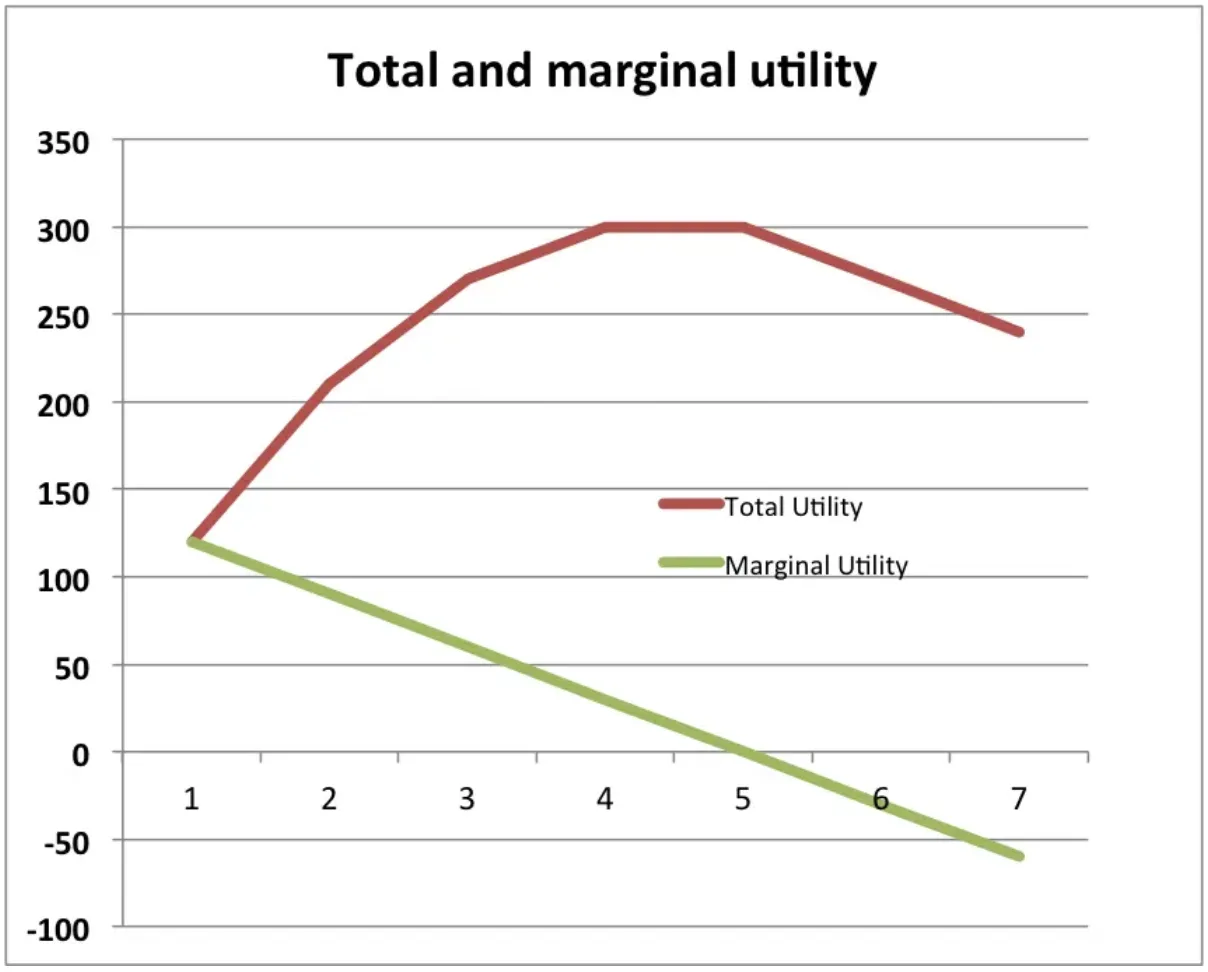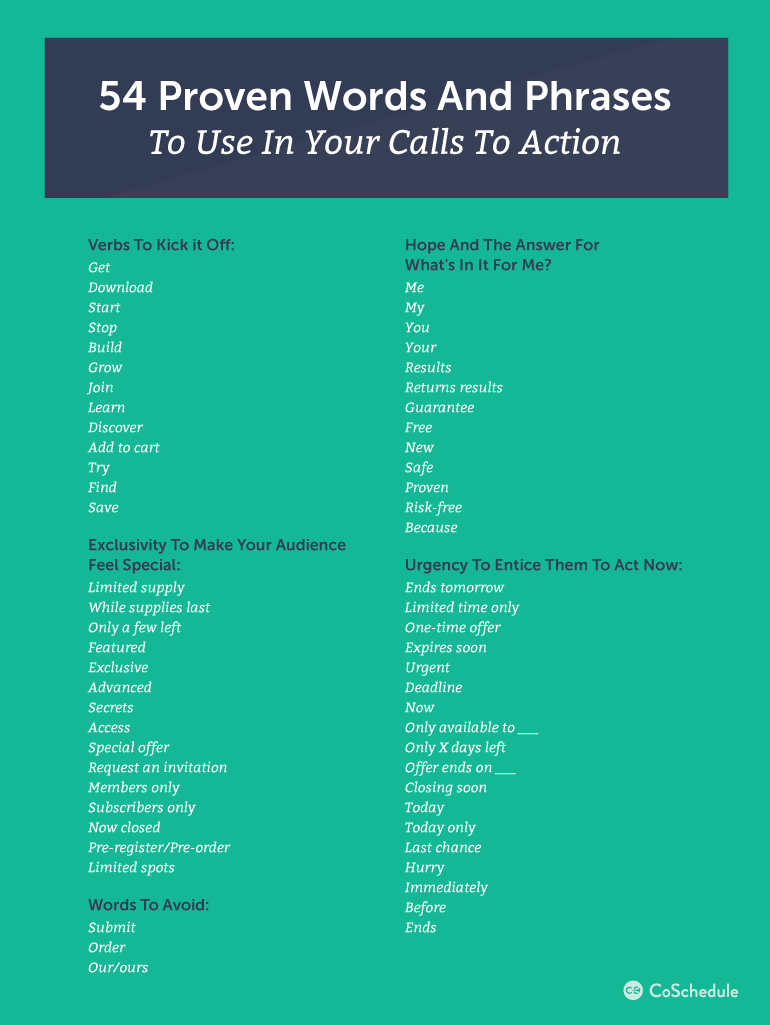33 Timeless Sales Tips to Convert Even the Most Frugal Leads

A man in a suit. Possibly wearing a top hat. Carrying a briefcase.
A real schmoozer, with an infinite smile.
The stereotype of a “pushy” salesman—which no one likes.
You want to grow your sales rates (duh) but…
The real question is how do you close without being that way?
Are there proven, research-backed tips that you can easily put to use on your next live-chat with a lead or client consultation?
There are, and today, I’ve put together a list of 33 proven (and timeless) sales tips that will help you convert more leads to sales.
In this article, I’ll show you:
- The 33 tested sales techniques and tips you can use to bring in more revenue, close more deals, and lock in more customers than ever.
- Real-world examples of how these tips and techniques have worked for companies who started using them.
- Actionable steps to take, hard statistics to consider, and insightful quotes from some of marketing’s biggest names in the industry.
So, grab your notepad and pen (maybe a top hat too), and get ready to take notes.
Want to delegate all your marketing and funnel work done—without the headaches of hiring? Download our free guide: 33 Marketing Projects You Can Delegate to Growbo and discover how to save 100+ hours a month, grow faster, and scale without the overhead.
And here’s a table of contents for you in case you want to skip ahead.
- Not All Buyers Are Created Equal
- Know When to Cut Your Losses
- “If You Believe in It, They Will Buy It”
- Figure Out Your Buyer’s “Type” & Play to That
- Know the Phrases That Flop & Avoid Them at All Cost!
- Know the Phrases That Sell & Use Them!
- Six Is the Magic Number
- Simply Being Authentic Isn’t Enough
- Don’t Be Afraid to Ask for Referrals
- There’s No “I” in Team
- Look at Things From Your Buyer’s Perspective
- Slow Down Your Pitch
- Confidence Is Key!
- The Proof Is in the Pudding—Give Your Buyers Substance
- Your Buyer Has Specific Needs—Listen to Them
- Know When to Let the Buyer Talk
- Don’t Underestimate the Millennials
- When You’ve Got a Good Thing Going, Don’t Change It!
- Peer Recommendations Are Everything—Make Sure You Play to That
- Don’t Take Your Time—Jump on Those Leads as Soon as Possible
- Simple Polite Behavior Will Take You a Long Way
- “If You Can’t Say Somethin’ Nice, Don’t Say Nothin’ at All”
- Use Social Media to Sell, Sell, Sell
- Scarcity Drives People to Act
- Stop Talking About Your Company
- Wednesdays & Thursdays Are the Best Days for Cold Calls
- Being Clear Leads to Conversion
- Don’t Forget to Ask Questions
- Less Is Not Always More
- Short, Sweet, & to the Point
- Set Better Goals
- Know When to Upsell
- Never Stop Learning

1. Not All Buyers Are Equally Valuable
Research by Invespcro shows that acquiring a new client costs 5X more than retaining an existing one.
Now, this doesn’t mean that acquiring new clients isn’t worth it. Actually, without new clients, growth wouldn’t happen.
What I’m getting at here is that before taking on a new client, make sure you’re effectively selling to your existing ones too.
A study analyzing 10K+ blog posts from Price Intelligently found that increasing the value of a current customer by just 1% led to nearly 10% more revenue than increasing acquisition by 1%.
Check it out.
Upselling and cross-selling are two of the best ways to boost that monetization.
And here’s why targeting existing customers works.
According to CrazyEgg, existing customers are as much as 65% more likely to buy from you than new customers.
On top of that, they’re 50% more likely to try out new products and tend to spend 31% compared to new customers.
So if you want you selling efforts to bring in more dough, be sure to target existing customers too.
2. Know When to Cut Your Losses
Walking away from a sales call without closing the deal can be tough.
When you’ve put time and energy into it but the sales call doesn’t pan out, it can often feel like a failure. In fact, the fear of that failure often gets people to double down on their efforts.
This doubling down is what’s known as the “Sunk Costs Fallacy.”
Take this example from Economics Help.
Say you buy 7 cakes (a bit overkill, I know).
And since you’ve already spent about $50 total, you feel like you have to eat all those cakes. Otherwise you’re wasting money.
But the problem is, with each cake you consume, you get less value per cake (a.k.a. “Marginal Utility”). And eating extra cakes makes you feel sick.
At some point, the total value (“Total Utility”) actually starts to drop by eating more cakes. Here’s what that looks like in graph form—economics nerds looooove using graphs.
See how that works?
Now, let’s relate that back to sales.
If you can learn when to walk away from a sales call that isn’t going to be valuable, you’ve already succeeded. You’re saving time. You’re saving money. And you can move on more quickly to the next prospect.
About seven years ago, I worked with one of the Inc.’s 500 fastest growing companies.
After dealing with an exceptionally difficult customer, the founder of the company taught me an important lesson.
He said, “We’re not going to work with clients that are going to be difficult right from the beginning.”
At the time, I was surprised by how blunt he was. Shouldn’t you always be accommodating to clients? What happened to “The customer is always right”?
But over time that rule has made less and less sense.
Especially in services, it’s important to work with clients who you believe fit not just in terms of problem solving but also who you’ll be able to have a healthy work relationship with.
Otherwise, you may be falling into the Sunk Costs trap like so many others.
3. “If You Believe in Your Product or Service, They Will Buy It”
Sales, or rather the success you have in sales, is often as much about what you’re selling as it is about you.
A recent study by Science Direct confirmed that sellers are more persuasive when they believe in what they’re selling.
If you personally don’t believe in the value of your product or service, how can your prospect believe in it?
Additionally, if your product or service doesn’t solve a problem or fulfill a need for your prospects, then it’s not a sustainable option.
Author, motivational speaker, and renowned salesman Zig Ziglar put it perfectly when he said:
“If you believe your product or service can fulfill a true need, it’s your moral obligation to sell it.”
And if you live by that creed, you’re bound to see your successful sales skyrocket.
4. Figure out Your Buyer’s “Type” & Play to That
Not every buyer wants or responds to the same pitch. No surprise there.
If you’ve been selling for any amount of time, you’ve likely figured that out.
Help desk software company Help Scout breaks down buyers into 3 main types: spendthrifts, unconflicted, and tightwads.
Here are some tips for selling to each type.
- Spendthrifts – Use plenty of emotional language to trigger buyers in this category. This category has a much higher buying pain threshold than the other categories so they aren’t driven by frugality as much (meaning price is important, but not as important). So spend extra time on showing them how your product will change their lives for the better.
- Tightwads – This is the opposite of the Spendthrift. Their buying pain threshold is far lower. And as a result, you’re going to have to spend plenty of extra time on showing cost value as well as hitting the scarcity and urgency points as much as you can.
- Unconflicted – These buyers make up the majority of your customers. They land somewhere between spendthrifts and tightwads. So try to balance cost-value appeals with emotional appeals in order to win over this type of buyer.
The key is taking time to prepare for a call. Do some research on the company, even on the person you’ll be pitching to.
While you’ll likely have a template you go by for your pitches, be prepared to add some personal touches along the way to play to your prospects “type”.
5. Know the Phrases That Flop & Avoid Them at All Cost!
A data science team with Gong.io analyzed over 500,000 B2B sales calls and found some of the top phrases that are sure to drop your close rates. Here are a few of the worst:
- “We provide” – If you’re trying to keep your pitch from feeling too “salesy”, using this simple phrase will cause your prospect to immediately put up their walls. In fact, when it’s used four or more times, close rates drop by 22%. Yikes.
- “Discount” – For prospects, hearing that a product or service has been discounted actually cheapens the value in their eyes. Using this word during your sales call can drop your close rates by 17%. Ouch.
- “Absolutely” & “Perfect” – Using these two words too often during your sales call will make you sound like an “eager-to-please”, fake salesperson. If you say them once or twice, don’t worry. But if used more than four times in a sales call, you’ll see a drop in close rates of 16%. Oof.
- “Show you how” – This one might be a little more surprising, and don’t worry, when used three or fewer times, there is no negative effect. After all, you’re trying to show your prospect how your service or product can solve their problem. However, when it’s used too much, your prospect only hears how your offer is great, but not why it’s great for them. Instead, position the benefits of your product differently with power words like “imagine.” When this phrase is used four or more times, close rates drop by 13%. Wow.
6. Know the Phrases That Sell & Use Them!
Now that we’ve covered the words and phrases you need to strike from your vocabulary, let’s talk about some that will boost your close rates and gain the trust of your prospects.
“Because”
Speaking of power words, “because” is one of the best around for sales.
In 2012, psychologist Ellen Langer conducted a study where an experimenter made a request to strangers using one of three different lines. The second two lines included the word “because,” explaining why the request was made.
The first line without “because” only had a success rate of 60%.
The second and third, both using the word “because,” had success rates of 93% and 94%.
Langer concluded that the simple addition of the word “because” was the key to getting strangers to comply with the request.
“Save” & “Free”
While “discount” may lower the value of a product in the prospects' eyes, hearing about an opportunity to save money will reel them in.
Any opportunity to save money while solving a problem is something both new prospects and pre-existing clients want to hear about.
Plus, there’s always “free,” one of marketing’s most magnetic eye-catchers in the biz.
“Now”
Using the word “now” when talking about your product or service creates urgency.
“Now” belongs to a group of words and phrases that are called “Action Words”—terms that are particularly good at driving action in your buyers.
CoSchedule actually put together a list of their own action words which are ripe for writing clickable CTAs.
Check them out below.
Action words like “now” give a little push to your prospect to move forward.
By helping your prospect understand that you can solve their problem now, you’ll help them make a decision sooner rather than later.
And the longer they wait, the lower and lower their chances are of closing the deal.
Urgency converts.
7. Six Is the Magic Number to Close the Sale
When it comes to increasing contact rates, six is the magic number.
Research conducted by Velocify found that making at least six attempts to contact a lead dramatically increased contact rates.
This plays on one of the 11 Laws of Sales Funnel Physics, “ The Law of Repetition”.
Basically, by hearing from or hearing about the same brand or person more and more over a period of time, a prospect is more likely to engage by picking up the phone or even buying a product outright.
8. Simply Being Authentic Isn’t Enough
I find that life is a lot easier when I'm just myself, especially when I’m on sales calls.
Clients tend to appreciate that authenticity.
And in turn, the more authentic you are, the more your prospects will be able to connect with you.
In fact, using unauthentic messaging is one of the biggest marketing mistakes you can make.
But authenticity without skill and technique won’t get you anywhere, except for maybe a few new friends.
The winning combo comes when you can be authentic in a sales call, but also use winning tips like the ones mentioned in this article!
9. Don’t Be Afraid to Ask for Referrals
Asking for a referral is one of the easiest and quickest ways you can grow your sales.
In fact, referrals drive more business than most people tend to realize according to Boston Digital.
See?
Yet many salespeople fail to even ask and are missing out on a valuable tool.
Texas Tech University actually found that 83% of customers report that they’re happy to share a referral after a positive experience. But if you never ask, you’ll never know.
According to research done by Marc Wayshak, 47% of top performers ask for referrals consistently. It’s no wonder why they’re listed as “top performers.”
So be sure to standardize asking your current clients for referrals. Because when you do, you’re much more likely to bring in highly qualified leads that are easier to sell to.
10. There’s No “I” in Team
There’s power behind using collaborative language.
You want to put yourself on the same team as your prospect. You do that by using words like, “we”, “us”, or “our”.
And try to avoid talking in first person too.
This will come naturally when you truly believe that your products or service are going to help.
But beware: using this type of language too frequently can make you come off cheesy, salesy, and disingenuous.
This, of course, can create the opposite effect of what you’re after and actually drive prospects away.
So use this technique sparingly at the start of your relationship with your prospect. And then, after they’ve displayed plenty of interest, then and only then should you ramp things up.
11. Look at Things from Your Buyer’s Perspective
Getting into the head of your audience is Marketing 101. The only way you can successfully get your prospects to buy is by figuring out who they are and what they want.
As Peter F. Drucker, one of the father’s of modern corporation philosophy, put it:
“The aim of marketing is to know and understand the customer so well the product or service fits him and sells itself.”

Now, the question is, how exactly do you do that when it comes to refining your pitch?
Well, one way is by actually taking a step back and listening to how you present it.
Jill Konrath shares a great story of how you can view your sales pitch from your prospect’s point of view.
She decided that rather than call her prospect and leave a voicemail right away, she would call her own number and leave the voicemail on her own phone so she could listen to her own pitch.
This allowed her to examine the pitch from a prospect’s point of view and ask herself if she would respond if she was the one being contacted.
After a few attempts and script rewrites, she came up with something that she would personally respond to and knew that it was finally ready for the prospect.
12. Slow Down Your Pitch
It can be easy to go into a sales call feeling eager and excited about what you have to offer. But that can come off to a prospect as if you’re rushing and pushing them into your service or product.
The last thing any prospect wants to feel during a sales call is like they’re being pushed into something.
If you rush your pitch, you’re going to come off as pushy. Simple as that.
Instead, take the time to slow down, take one step at a time.
How do you eat an elephant? One bite at a time.
How do you crush a sales pitch? One step at a time.
This is especially good advice for high-ticket items. See, the higher the cost of your product or service, the more a prospect needs to be convinced of its value in order to be sold on it.
They need more nurturing.
So instead of getting right to the pitch, take time to point out how you can benefit their lives. Compare what you’re selling to the competition. And always remember to address as many buying objections upfront as possible.
13. Confidence Is Key!
Similar to believing in your product, if you don’t believe in yourself as a salesperson, regardless of how great your product or service is, your sales will suffer.
Confidence is a huge determinant for success.
When you’re confident, you believe that you’ll be able to sell. You believe that you’ll reach the goals you set.
And because of it, your motivation increases and you work harder and better than ever before.
Tony Robbins says that success is 80% psychological and 20% strategic.
If confidence in your sales is something you lack, one of the best ways to boost your sales confidence is by training yourself on sales strategies.
According to Salesforce, just 4% of a sales rep’s day is devoted to increasing their skills.

Instead, try to carve out more time for bettering yourself and learning proven sales techniques.
Because as the old school-house saying goes, “Knowledge is power.”
14. The Proof Is in the Pudding—Give Your Buyers Substance
Prospects don’t want a pitch full of “could” and “would.” They want cold, hard proof.
An explanation of how your product or service can help solve their problem is great, sure. But if you don’t have any proof to show how it’s been successful for others, it’ll fall flat.
This is why one of the number one things we do for our clients’ websites and landing pages is adding social proof, whether through testimonials, “as seen on” icons, “features” and more.
In fact, adding proof of your product’s effectiveness is one of what we call “God-Mode” sales strategies.
It’s why we have tons of social proof scattered around our own homepage too.
Social proof like testimonials…

Publications mentions…

And vanity stats…

In the end, the more social proof you can put on the page, the better.
15. Your Buyer Has Specific Needs—Listen to Them
You’ve likely been taught how important it is to listen to your prospect: to their needs, their problems, and whatever else they have to say.
Every salesperson knows it’s important to listen.
But listening is not the same as active listening.
Here’s the difference between just listening and actively listening...
Listen without an agenda.
Don’t just be listening and thinking about how that sentence they just said leads perfectly into your next topic.
Don’t use their comment as just a segway.
Instead, listen for real.
Most importantly, listen to what they say they need, not to what you think they need.
Forbes actually lists this as one of the most important relationship-building skills to create satisfied loyal customers.
One way to show your prospects that you are actually listening to what they are saying is by repeating their concerns.
Instead of just launching into how your product can solve their problem, try leading into that solution by saying, “I’m hearing that you’re worried about X. And that’s a valid concern. But what [Your Product] does is it actually solves that problem at the source.”
Sometimes something as simple as repeating their problem is enough to prove that yes, you are in fact actively listening.
16. Know When to Let the Buyer Talk
This is one goes along with the last point.
One of the most common recommendations that comes from seasoned sales professionals when they’re teaching new salespeople is to shut up and listen.
And it’s 100% true.
Listen. Ask Questions. Really try to understand what the prospect thinks, because that’s really what matters at the end of the day.
Aside from sales, being understood is a fundamental human need that everyone craves. If you can meet that need in your sales call, you’ll be that much closer to creating a loyal customer.
And once you’ve listened, show that to the prospect by incorporating their feedback into your response.
One technique to follow every time you’re in a sales meeting is the 60-Second Rule.

Best-selling author Marc Wayshak says this about The 60-Second Rule:
“The 60 Second Rule is simple: You should never speak without interruption for more than 60 seconds during a sales presentation. This is one of the most effective quick sales presentation tips out there.”

So next time you’re in a sales pitch meeting, try keeping track of how long you are talking. Because in all likelihood, it’s probably a lot longer than you should be.
17. Don’t Underestimate the Millennials & Gen Z’ers
There are plenty of memes and stereotypes floating around about the younger generation.
That they’re lazy. That they don’t work. That millennials and gen z’ers just spend their time taking pictures of their food or selfies.
But if you listen to these stereotypes, you risk missing out on one of the most powerful groups in the market.
A recent Google consumer insights report found that millennials make up half of the buyers on the market today.
And according to Epsilon Research, while millennials and gen z’ers don’t spend quite as much per transaction as other generations, they do perform plenty more transactions on average—as much as almost 75% more.

So if you put younger generations into your “do not contact” box, you’ll be missing out on a massive and valuable opportunity.
18. When You’ve Got a Good Thing Going, Don’t Change It!
One trap salespeople can fall into is thinking that they always need to be changing their tactics.
While making sure you’re staying flexible with your sales strategy is good for the most part, there is value in maintaining something that is seeing success.
If you have a tried and true tactic that works for your sales calls, don’t change it just because you think you need to!
Yes, you should always be adapting to new technologies and new opportunities. But if the “sales” shoe fits, wear it!
19. Peer Recommendations Are Everything—Make Sure You Play to That
Data collected by the Harvard Business Review found that peer recommendations influence over 90% of B2B buying decisions.

Prospects are spending more and more time conducting research online and talking with trusted colleagues about recommended solutions for their problems.
So if they aren’t reaching out to you during this process, how can you get your product or service in front of them?
Back in tip #14, I mentioned that here at Growbo we’re always adding value to clients’ landing pages by adding testimonials. This is the key.
If you can get your happy clients to share their positive experiences with their colleagues, you’ll have a foot into that important research process.
20. Don’t Take Your Time—Jump on Those Leads as Soon as Possible
This one’s simple. The sooner you can reply to a lead, the better result you’ll get.
Simply put, the quicker you can respond to a lead, the less likely they’ll go cold and lose interest in what you’re selling.
Another study from the Harvard Business Review which looked at 2,241 different B2B sales teams found what’s been called “The 5-Minute Rule.”
Not to be confused with “The 60-Second Rule,” this rule states that leads who are contacted within 5 minutes of showing interest are dramatically more likely to convert.
Check it out.

Here at Growbo, we recently had a personal experience based on the need to follow up quickly.
We have a booking widget on our website that was only accepting bookings for Mondays, Wednesdays, and Fridays. I realized that this was keeping many of our leads from receiving the information they wanted right away.
Opening those bookings up to Monday through Friday allowed our leads to talk with us that same day or the next day rather than having to wait two days to be contacted.
This relates to the Law of Range, or the thought that the more options you give people, the more likely they are to convert.
21. Simple Polite Behavior Will Take You a Long Way
Another easy one here: just be polite.
How hard is that?
A study from Tipping.org found that hotel waiters that said “good morning” to guests and gave them a positive weather forecast saw a 27% boost in tips.
For salespeople, simply starting a sales call with the basics, “good morning”, “how are you?” can go a long way.
That polite behavior, as long as it comes off genuine, will facilitate trust and comfort with the prospect, which will, in turn, open them up to hear about what you have to offer.
22. “If You Can’t Say Somethin’ Nice, Don’t Say Nothin’ at All”
Thumper was on to something when he made this statement, in the Disney classic movie Bambi.
Have you ever heard of spontaneous trait transfer?
Basically, it’s a phenomenon where you are perceived as having the traits of someone you’re describing to the listener.
So if, for example, you choose to trash your competitor, rather than your prospect thinking less of your competitor, they may actually see you as having those poor traits too.
Wild stuff, huh?
On top of that, it looks downright unprofessional to badmouth other businesses.
My advice? Leave your competitor out of the conversation entirely and you’ll be safe.
23. Use Social Media to Sell, Sell, Sell
This tactic may not be the most “timeless” but it’s one of the most important in the modern world of sales.
91% of B2B buyers are active on social media.
Social media is incredibly valuable for sales.
PricewaterhouseCoopers, one of the most renowned professional services networks in the world, found that a whopping 37% of consumers get their purchasing inspiration from social media—more than any other marketing channel.

Social media is more and more becoming a tool for prospects to quickly and clearly see what businesses like you have to offer and easily reach out to you for more information.
So rather than spending time seeking out leads on other platforms, don’t forget to start with the place where you know they are—on social media.
However, you do need to be careful about buyer intention when it comes to marketing on platforms like Facebook and Pinterest.
Because most of the time, people on these platforms are simply looking to connect with friends, not be hit with product advertisements and sales pitches.
24. Scarcity Drives People to Act
Have you ever noticed how Amazon will notify a buyer when there are only a few of the items they’re looking at left? Etsy and plenty of other businesses do it too.
This is no accident. It’s scarcity marketing.
FOMO, or the fear of missing out, is a real thing. No really, it’s been scientifically proven.
The pain of missing out on something is almost two times as powerful as the feeling of gaining something.
People are more willing to take a risk or act on an opportunity to avoid a loss.
And as a marketer, you can use that natural tendency to your advantage.
For example, one case study from our Proven Sales Conversion Pack showed how a company grew their revenue by nearly 25% just by implementing scarcity messaging.
Here are two of their CTA boxes before the change…
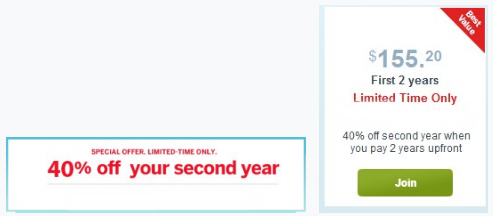
And here they are after…

By putting a hard date on the offer expiration, they saw a whopping 24.5% revenue growth.
That’s nuts! And it’s super simple to pull off too.
So if you want to get more people to act on the product or service you have, make it scarce.
25. Stop Talking About Your Company
You know how people always make fun of name droppers?
When you are constantly dropping your company’s name in a pitch, you’ll become one of those people others make fun of.
And if not made fun of, you certainly won’t appear any more trustworthy or genuine, thus hurting your chances at closing the sale.
In fact, talking too much about your company in a sales call is highly correlated with negative conversion outcomes. It’s another big no-no cited by sales gurus like Marc Wayshak.
In general, prospects don’t care about the information and background of your company. Instead, they just want to know if what you’re offering can help to solve their problem.
So stop talking about your company, and start talking about the specific product or service. That’s all that matters to your prospects in the long run.
26. Wednesdays & Thursdays Are the Best Days for Cold Calls
If you’ve ever noticed that there are specific days of the week that seem to work better for cold calls, you’re on to something.
Research from commercial real estate CRM Digsy found that the best days for cold calls are right in the middle of the week, Wednesday and Thursday, Thursday being slightly better.
On top of that, the best times to call are 8-9 am and 4-5 pm.

If you stop to think about your own workweek, this makes sense.
Monday is busy catching up from things missed over the weekend, and Friday is full of last-minute cramming before the weekend starts.
Contacting prospects on the days and times when they’re less likely to be slammed will result in more successful contacts.
27. Being Clear Leads to Conversion
As Dane Maxwell says, “Better to be clear than clever.”
And it’s the same thing we’ve been preaching for years.
In fact, one of our most important tips for creating a high-converting sales page is to be clear, not clever with your copywriting.
Same goes for writing eye-catching headlines.
The last thing you want is for your prospect to leave a sales call feeling confused in any way about your service or product.
While creativity has its place in sales, if it comes in the way of the prospect’s understanding, it’s not worth it.
28. Don’t Forget to Ask Questions
You expect to get questions from a prospect during a discovery call, but have you prepared questions of your own?
Asking questions during a discovery call allows you to get a feel for what the prospect needs and expects from you.
Gong.io conducted an analysis to find the ideal number of discovery questions to ask during a call. The number that correlated the highest success rates was 11-14 questions.

Does that seem like a lot? Possibly.
But when you’ve got a full understanding of a prospect and what they need to be converted, you’ll be glad you asked so many questions.
29. Reach Out to as Many Prospects as You Can
You know the common phrase “less is more”?
Forget it when it comes to reaching out to prospects.
Because when you’re in sales, you’ve got to spend the time required to reach out to as many prospects as you can.
Research conducted by Marc Wayshak found that 81% of top-performing salespeople spend 4 hours or more a day on sales-related activities, prospecting being one of them.
See how that compares to lower-performing salespeople in the graph below.
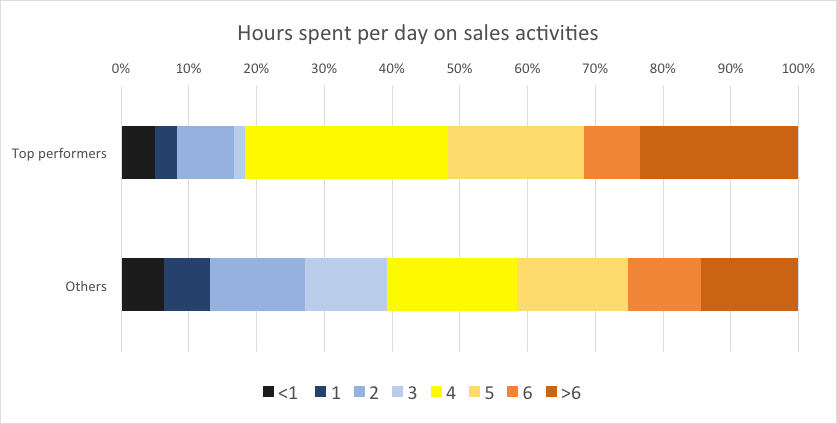
In contrast, it looks like lower-performing salespeople only spent about 60% of their time on sales activities—that’s about a quarter less time.
There’s no confusing mathematical equation for it. The more prospects you reach out to, the more success you’ll have.
So quit the procrastinating. Stop the lollygagging. And sit down, shut up, and put in the work.
Because in sales especially, it can go a long way towards a healthier bottom line.
30. Keep Your Pitch Short, Sweet, & to the Point
Have you ever listened to a training session and felt like it was dragging on and on and on and on…
That’s how your prospects feel when you give them a lengthy sales pitch.
Their eyes start to glaze over and they stop thinking about whether this is a good fit... and start thinking about when this thing is finally going to end.
Keep your pitch short, sweet, and to the point.
This will keep it clear for your prospect and won’t make them want to run for the hills.
This is especially important to remember for cold leads.
If, however, your leads are warmer and more qualified before you get on the phone, then by all means, don’t hold back.
But remember: be sure to follow The 60-Second Rule from above!
Even the most interested parties will gradually lose interest when you’re monologuing for too long.
31. Set Better Goals
How many times have you set goals for New Years?
And how many times have you actually stuck to them?
Setting goals is a great way to motivate you and keep you working. But if they aren’t the right goals, just like most New Year's resolutions, they’ll be dropped after just a few weeks.
If you set goals that are too ambitious, you’ll give up easily.
If you set goals that are too easy, there will be no room for growth.
The key is finding your middle ground. I can’t tell you what that is, because it’s different for everyone.
What I can tell you is that setting a mix of both short term and long term goals will help a salesperson like you be more motivated, confident, and overall more effective.
And in that same vein, you also need to be able to track those goals.
And that’s where KPIs (or key performance indicators) come in. These are stats that you need to measure and track along the way to show just how successful your efforts are.
Because as I’ve said in the past, “What gets tracked gets done.”
Without quantifiable progress towards a goal, you won’t ever know how close you’re actually getting to achieving that goal.
32. Know When to Upsell
I mentioned upselling a little bit before and how it can increase the monetization of existing customers. But I will emphasize it just a bit more.
Why? Because upselling should be a huge part of your marketing strategy.
And if it isn’t already, then you’re simply throwing money out the window.
Upselling is basically offering an upgraded version of an item to people who are about to check out. And it’s a great tool to grow your revenue with customers that already want your product or service.
There’s also cross-selling—offering current customers a similar product (think Amazon’s “Frequently Bought Together” feature).
But in reality, cross-selling is far less effective than upselling. Take a look at how less effective it is below.
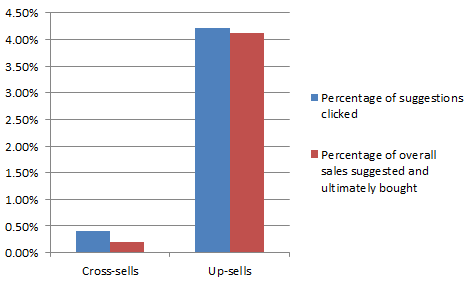
But many salespeople fail to offer either the cross-sell or the upsell. You may think, “The sale is going good and I don’t want to risk it.”
If the client doesn’t want to scale up, no harm done. But if you don’t offer the upsell, you may be missing an opportunity to boost the dollar amount of their purchase.
And to make things even easier for you, we’ve already put together a list of the 7 best upselling strategies.
33. Never Stop Learning
To truly win in sales, you have got to remember this one thing...
Never. Stop. Learning.
The business and sales world is always changing and growing. And if you aren’t learning, you’re falling backward.
So stay up to date on new products and technology. Attend trainings to keep your skills fresh. Take courses to learn new techniques. And learn from the feedback you get from each sales call.
I recommend one of Growbo’s 6-Figure Sales Funnel Training packages. They come with lesson modules, video coaching, and training workbooks that will help you build a sales generation funnel that will skyrocket your leads.
But no matter what you do, never stop learning!
Conclusion
Want to delegate all your marketing and funnel work done—without the headaches of hiring? Download our free guide: 33 Marketing Projects You Can Delegate to Growbo and discover how to save 100+ hours a month, grow faster, and scale without the overhead.
You made it!
These 33 sales tips are proven to convert, and if you apply them to your sales strategies, you’ll see major growth.
Okay, okay the thought of applying all 33 of these tips at once to your sales may seem overwhelming. So here are some of my key takeaways:
- Learning when to cut your losses will save you from working with clients that ultimately aren’t right for your company.
- The confidence you have in the value of your service or product will have a key impact on your success selling it.
- Increasing your attempts to contact a lead, at least six times, will dramatically increase your contact rates.
- Shut up and listen. Listening to your prospect and understanding their needs and desires is what really matters at the end of the day.
- Authenticity is great, but if it’s not paired with good skills and techniques, you won’t be successful.
- Using collaborative language, like “we” and “our”, will make your prospect feel like you’re on the same team.
- Don’t take your time reaching out to leads. The sooner you get them the information they want, the higher the chances they’ll convert.
Now tell me something, which of these tips have you had a positive experience with? Which do you plan on implementing right away? And do you have any other timeless sales tips to share?
Let me know in the comments below.
And as always,
Keep convertin’, stay focused.




